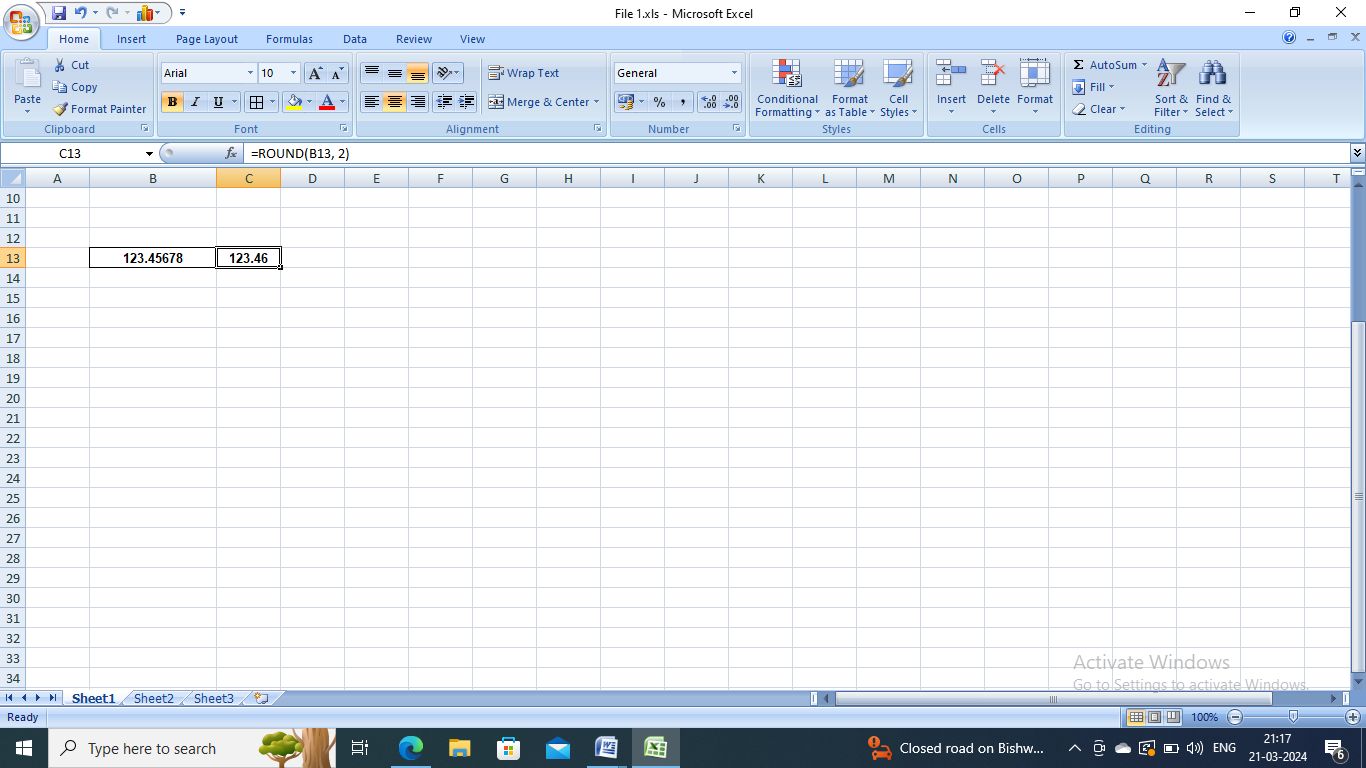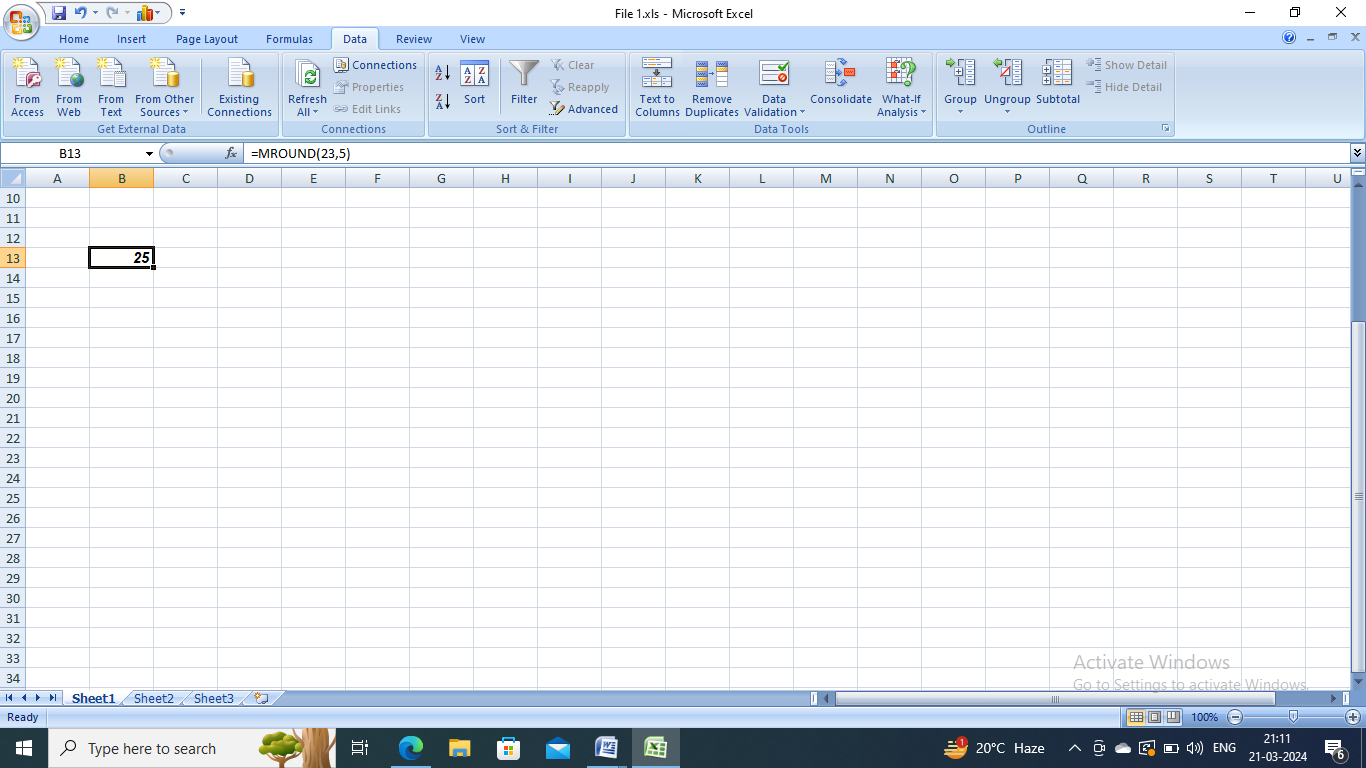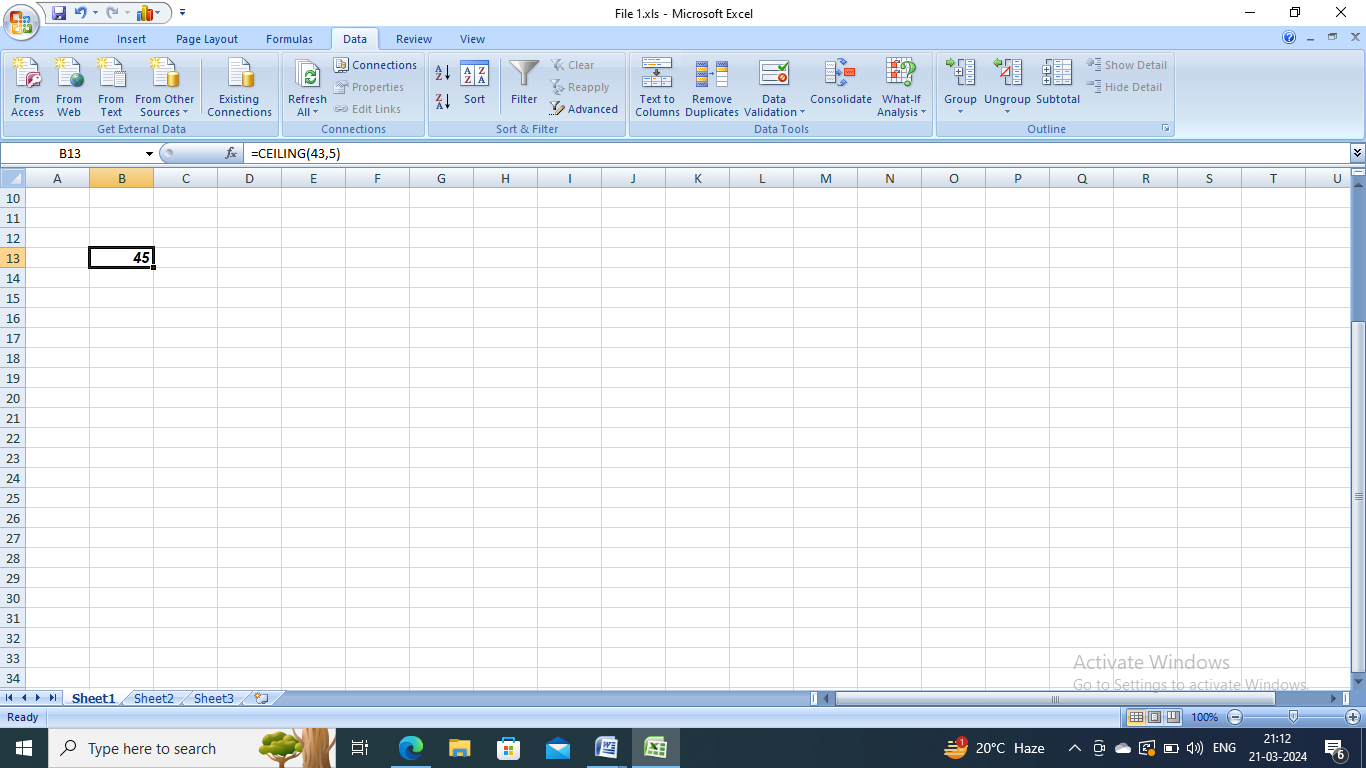Working professionals
Fresh graduates
- Study abroad
- Offline centres
More
27. Columns in Excel
33. Count In Excel
49. Slicers in Excel
54. Solver in Excel
56. Macros In Excel
Round Off Formula in Excel
Let’s say you work in the health sector and have a blood pressure reading of 123.45678. To make the data digestible, you have to round it off to two decimal places.All you have to do is slap the round off formula in Excel, and voila! Your data will be neatly rounded. In an age where data accuracy is paramount, Excel is a great option for performing data-related tasks efficiently.
While there are many data management and analytical software available in the market, Excel is my favorite due to its many computational capabilities, simplicity, ease of use, and accuracy. Whether you are crunching numbers in the health sector or tackling financial data, Excel can get your job done with ease and utmost precision. It has functions like ROUNDUP, ROUNDDOWN, CEILING, FLOOR, etc., that can cater to your varying rounding off requirements.
In this tutorial, I will be discussing the different functions using which you can round off your data. Stick through till the end to learn more about the different types of round off formula in Excel.
The Rounding Functions in Excel
The round up function in Excel can be used for a variety of rounding needs. Be it for general approximation or something specific, Excel has functions to cater to every requirement.
Let me take you through some of the most used round off formula in Excel with examples to elucidate how to round off numbers in Excel.
1. ROUND
This function is a standard unit in Excel that is used to round a given number of digits. The syntax for this is =ROUND(number, num_digits).
Here, number refers to the value that you want to round, and num-digits signifies the number of digits to which a user wants to round. Note that positive numbers round to decimal places, negative numbers round to the left of the decimal point, and 0 rounds to the whole number that is the nearest.

2. ROUNDUP and ROUNDDOWN
The ROUNDUP and ROUNDDOWN functions are essential for rounding a number, and removing the lesser significant values so that the notation can be kept as close as possible to the original value.
The syntax for the two are:
Round up function: =ROUNDUP(number, num_digits)
Round down function: =ROUNDDOWN(number, num_digits),
where number is the number that you want to be rounded, and num_digits is the place where the number should be rounded.
In the case of the ROUNDUP round off formula in Excel, the rounding is done on the decimal’s right side. If the value of num_digits is less than or equal to zero, then the rounding is done to the left of the decimal point.
Similarly, in the ROUNDDOWN function, if the num_digits value is larger than 0, the figure is rounded to a given number of decimal places. If the value of num_digits is 0, then the rounding off is done down to the nearest integer.
3. MROUND, CEILING, FLOOR
Excel has some more advanced options that are used for rounding. Let me list them down for you.
MROUND: The syntax of the MROUND function is =MROUND(number, multiple). Here, number denotes the number you want to work on, and multiple signifies the number whose multiple you want the result to be.
This round off formula in Excel helps round a number to the nearest multiple mentioned in the syntax. For instance, if you write =MROUND(23,5), you will get the result 25.

CEILING: Using the CEILING function, you will be able to round a number up to the nearest specified multiple. The syntax for this function is =CEILING(number, significance).
For example, if you write =CEILING(43,5), the result 45 will appear.

The main objective is to understand the data's context and perform the function that best meets your requirements.
FLOOR: This round off formula in Excel rounds down selected numbers to a value below them. The syntax for this function is =FLOOR(number, significance).
Let us understand this round off formula in Excel with an example. If we have a reading 127.93, and we apply the FLOOR function to it with significance 1, the value will be rounded down to the nearest integer, i.e, 127. If we put 2 as significance, the value will be rounded down to 126.

Some Common Mistakes to Be Aware Of
While using the round off formula in Excel has its fair share of advantages, I encountered some mistakes in the process as well.
Now that we have a fair understanding of how to round off in Excel, I'll list down the most common mistakes that you should be aware of.
1. Make sure that the number of digits specified is correct: If you misjudge the value for num_digits in your round formula in Excel, your data will be rounded off to the nearest tenth.
To avert this, always cross check the values that you are putting for num_digits.
2. Confusion regarding the direction of rounding: I personally have suffered a lot due to this. I often used to get confused between ROUND with ROUNDUP or ROUNDDOWN. This leads to the data being rounded in a direction that you do not want.
People also tend to get confused between FLOOR and CEILING. Therefore, choose the functions wisely.
3. Anomaly with negative numbers: Some rounding functions work differently with negative numbers. For instance, the CEILING function rounds away from zero, i.e., it rounds to a higher absolute value.
Although Excel has formulae designed to ease human tasks, I’d strongly advise all to pay attention to detail. This will make it easier to handle data with the utmost precision and avoid any dicrepancies.
Some Practical Uses of Rounding Off
Now that I've elaborated on the different ways in which you can use the different variants of the round off formula in Excel, let me list some real-life examples where rounding off helps. These examples will give us a better understanding of the relevance and utility of this function.
1. Financial reporting: If you ever have to work with financial data, you will see that your data has several decimal points. In this situation, it becomes important to round off the data for easier presentation and reading.
In this case, using the round off formula in Excel will help standardize all the monetary values. Your data figure will come down to two decimal places, representing cents.
2. Inventory management: Professionals working in the manufacturing unit and dealing with raw materials have to ensure accurate representation of quantities. For this, they need to represent their data in whole units.
Therefore, if they use the ROUNDUP function, they can have slightly more than the requirement, thereby avoiding any potential shortage.
3. Research and data analysis: When conducting research, you must present data in graphical form. Rounding off figures before plotting them helps to provide visual clarity.
Wrapping Up
The use of round off functions is evident across industries. Although the function remains the same, it can be tailored based on the varying needs of the users. Aligning the use of round function in Excel with the task helps ensure the accuracy and actionability of the data.
While I’ve discussed how to do round off in Excel in detail in this tutorial, you can learn more about such Excel functions simply by signing up for a course. I have found upGrad’s courses to be highly effective. They will help you enhance your data management skills and master Excel functions for easing time-consuming data-related tasks.
Frequently Asked Questions
1. How do you round formulas in Excel?
To round off in Excel, you have to use the formula =ROUND(number, num_digits). To round off in Excel, you have to use the formula =ROUND(number, num_digits) .
2. How do I round to 2 decimal places in Excel?
If you want to round to 2 decimal places, you have to use the syntax =ROUND(number, num_digits), and put 2 in place of num_digits. If you want to round to 2 decimal places, you have to use the syntax =ROUND(number, num_digits) , and put 2 in place of num_digits .
3. How do you round down a formula in Excel?
To round down a value in Excel, you have to use the syntax =ROUNDDOWN(number, num_digits). To round down a value in Excel, you have to use the syntax =ROUNDDOWN(number, num_digits) .
4. How do you round off numbers?
There are several functions in Excel, like ROUND, ROUNDUP, ROUNDDOWN, FLOOR, CEILING, and MROUND, that are used for rounding off.
5. Why do we round off give 5 examples?
We round off numbers to: simplify communicationfacilitate estimationmaintain a desired level of accuracy in calculationsuphold data accuracyconform to the units or standards, for instance, in science, finance, etc. simplify communication facilitate estimation maintain a desired level of accuracy in calculations uphold data accuracy conform to the units or standards, for instance, in science, finance, etc.
6. How do you round off 5?
We can round off 5 using the rounding convention called "round half up" or "rounding to nearest." This means that when a number ends in 5, it is rounded up to the nearest whole number. You can use either ROUND or MROUND to round off 5 to the nearest whole number. We can round off 5 using the rounding convention called "round half up" or "rounding to nearest." This means that when a number ends in 5, it is rounded up to the nearest whole number. You can use either ROUND or MROUND to round off 5 to the nearest whole number.
7. What are the 4 rules of rounding?
The 4 rules of rounding are as follows: The ROUND function is used for general rounding. It rounds down values less than 5 and rounds up for values more than 5 unless ROUNDUP and ROUNDDOWN is mentioned.MROUND helps round to the nearest multiple.FLOOR function helps to round down to the nearest specified multiple.The num_digits argument in the round off functions specifies the multiples to round to or the decimal places. The ROUND function is used for general rounding. It rounds down values less than 5 and rounds up for values more than 5 unless ROUNDUP and ROUNDDOWN is mentioned. MROUND helps round to the nearest multiple. FLOOR function helps to round down to the nearest specified multiple. The num_digits argument in the round off functions specifies the multiples to round to or the decimal places. The num_digits argument in the round off functions specifies the multiples to round to or the decimal places.
8. What is an example of round off?
If we have a number 13.4675, and we use the ROUND syntax, where the value of num_digits is 2, the displayed result will be 13.47. If we have a number 13.4675, and we use the ROUND syntax, where the value of num_digits is 2, the displayed result will be 13.47.

Author|15 articles published


upGrad Learner Support
Talk to our experts. We are available 7 days a week, 10 AM to 7 PM
Indian Nationals
Foreign Nationals
Disclaimer
The above statistics depend on various factors and individual results may vary. Past performance is no guarantee of future results.
The student assumes full responsibility for all expenses associated with visas, travel, & related costs. upGrad does not .























-ae8d039bbd2a41318308f8d26b52ac8f.svg)
-35c169da468a4cc481c6a8505a74826d.webp&w=128&q=75)
-7f4b4f34e09d42bfa73b58f4a230cffa.webp&w=128&q=75)



